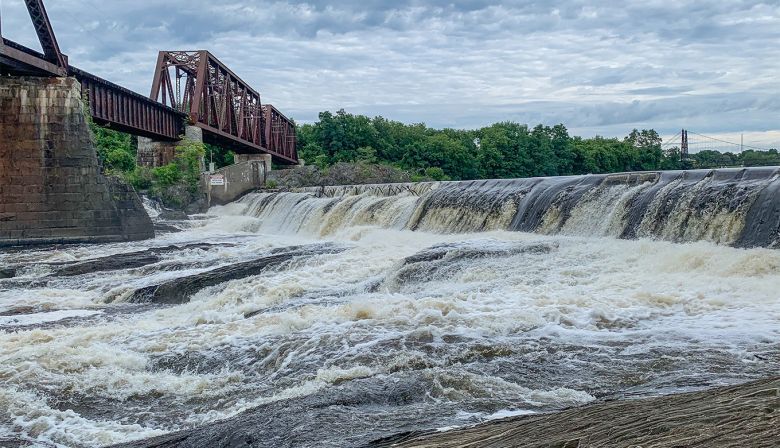Rivière Mitis River
The number of fish migrating back to the Mitis this season continues to very encouraging.
As of July 28th 2020, a total of 1,228 fish have been transported upstream (643 salmon and 585 grilse).
Compared to July 30th 2019 when 357 large salmon and 344 grilse had been counted for a total of 701.
Also, to date for the 2020 season, 136 have been reported landed including 68 salmon released and 68 grilse reported harvested.
To July 30th 2019, 39 fish had been reported landed including 35 salmon released.
A 28 juillet 2020, les gestionnaires de la Mitis sont plus que satisfaits des résultats de montaison et la performance du nouveau piège de capture.
À date, 1,228 poissons furent transportés en aval du site de capture, dont 643 grands saumons et 585 madeleineaux. A pareille date en 2019, 701 poissons (357 saumons et 344 madeleineaux) furent dénombrés.
Au 27 juillet 2020, les résultats de pêche cumulatifs indiquent 136 prises (68 saumons furent relâchés et 68 madeleineaux récoltés. Comparativement au 31 juillet 2019 lorsque 75 prises furent déclarées comprenant 35 saumons relâchés et 40 madeleineaux récoltés.
Rivière de la Trinité River
As of July 28, 2020, 255 fish have been counted through the fishway comprised of 84 salmon and 171 grilse. 37 fish have been reported landed, 14 salmon and 3 grilse released, 20 grilse harvested.
To July 27, 2019, a total of 194 fish had been counted through the fishway (77 large salmon and 117 grilse). Regarding captures, 33 fish had been reported landed including the releases of 13 salmon and 1 grilse.
3,668 sea trout have also been counted to July 28th, compared to 1,381 at the same time in 2019.
Au 28 juillet 2020, 255 poissons avaient été dénombrés dans la passe migratoire composée de 84 saumons et 171 madeleineaux. 37 prises ont été déclarées jusqu’à ce jour, 14 saumons et 3 madeleineaux reclachés, 20 madeleineaux récoltés.
Au 27 juillet 2019, 194 poissons avaient été dénombrés par le biais de la passe migratoire (77 saumons et 117 madeleineaux). En ce qui concerne les captures, 33 prises furent déclarées dont 13 saumons relâchés et 1 madeleineau récolté).
3 668 truites de mer sont également dénombrées au 28 juillet, comparativement à 1 381 à pareille date en 2019.
Rivière Rimouski River
Records to July 27, 2020, indicate 325 fish (183 salmon and 142 grilse) have been transported above.
In 2019, the cumulative count at July 27 indicated 463 fish (243 salmon and 220 grilse).
To date in 2020, a total of 43 fish have been landed including 24 salmon released and 21 grilse harvested compared to a total of 96 fish landed (55 salmon released and 41 grilse harvested) in 2019.
Cumulativement au 27 juillet 2020, 325 poissons ont été comptés (183 saumons et 142 madeleineaux) ont été transportés en amont de la chute infranchissable.
En 2019 à pareille date, 463 poissons furent comptés comprenant 243 saumons et 220 madeleineaux.
Au 27 juillet 2020, les résultats de pêche cumulatifs indiquent que 43 prises ont été déclarées, soit 24 saumons relâchés et 21 madeleineaux récoltés. Comparativement au 27 juillet 2019 lorsque 96 prises furent déclarées comprenant 55 saumons relâchés et 41 madeleineaux récoltés.
Rivière Bonaventure River
The mid-season count was performed from July 27 to 29 and revealed 1,106 salmon and 429 grilse for a total of 1,535 fish. Also, 6 striped bass were observed in the system (Sectors B1, B3, B4). The mandatory release of large salmon will continue until the season end on September 30th.
The 2019 mid-season count revealed a total 1,195 fish comprised of 1,023 salmon and 172 grilse.
This season to July 25th, 698 fish have been reported landed by anglers including 465 salmon released and 233 grilse that were harvested. In 2019 on July 27th, to date, 645 fish had been reported landed including 521 salmon released and 124 grilse harvested.
Du 27 au 29 juillet, le décompte de mi-saison fut complété. 1,535 poissons ont été observés comprenant 1,106 saumons et 429 madeleineaux. Également, 6 Bars Rayé furent identifiés dans les secteurs B1, B3 et B4.
Le décompte mi-saison en 2019 a révélé la présence de 1,195 poissons dont 1,023 saumons et 172 madeleineaux.
Cumulativement au 25 juillet, les saumoniers de la Bonaventure ont déclaré 698 prises dont 465 saumons remis à l’eau et la récolte de 233 madeleineaux.
Au 27 juillet 2019, les saumoniers avaient déclaré 645 prises, dont 521 saumons remis à l’eau et 124 madeleineaux récoltés.



















